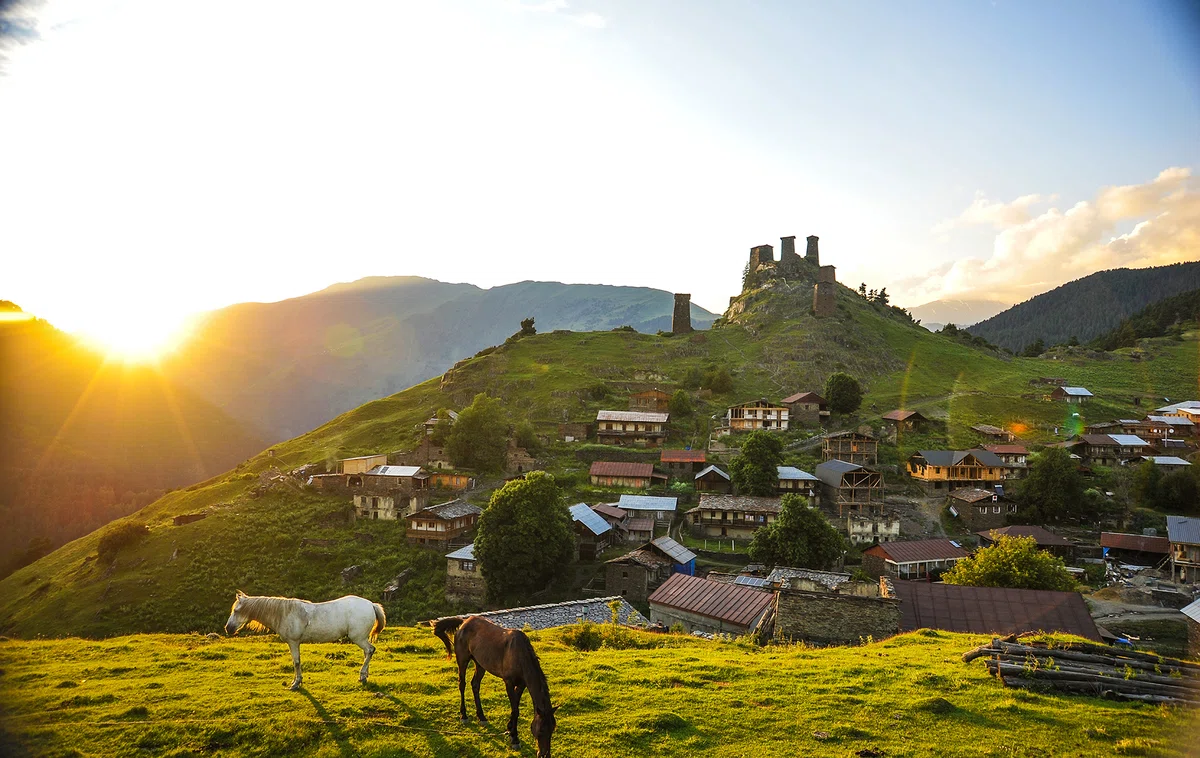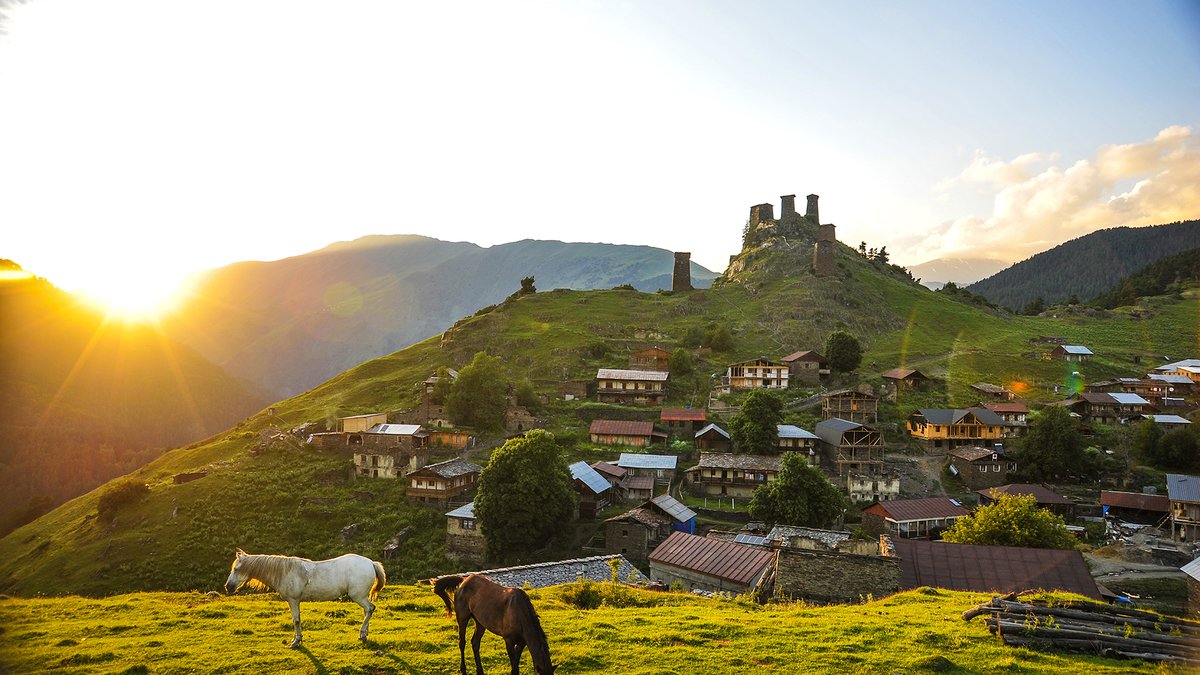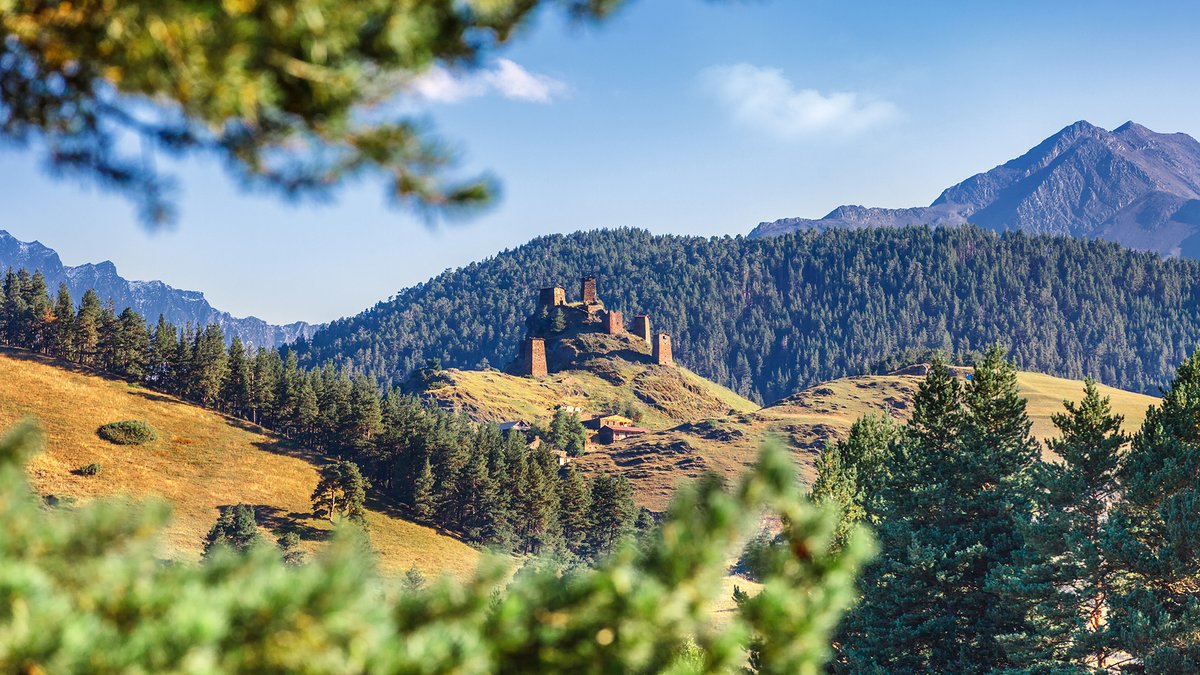
The best resorts of Kakheti. Resorts in Georgia. Visit the Tusheti resort.
Tusheti is not the most easily accessible place, but you can get here by road. Tusheti resort is a high–altitude place with a unique natural climate, clean fresh air. The resort is very popular among tourists, so be sure to visit it not only for the sake of wellness, but also for the sake of visiting many natural attractions.
Tusheti one of the most mountainous and inaccessible regions of Georgia. It is located in the north-east of the country, on the northern slopes of the Caucasian ridge, at an altitude of 1650-4493 meters above sea level. Khevsureti adjoins it from the west, Kakheti from the south, and the Russian Federation from the north. Administratively , Tusheti is part of Kakheti region, in particular, to the municipality of Akhmet.

ABANO TORGVA RESORT
The only road leading to Tusheti starts in Kakheti, in the village of Pshavli and ends in Omalo through the highest crossing in Georgia - the Abano Pass. During the year, this Road operates only for a few months - from May to September. And over these months, it has been repeatedly cleared of landslides and rock fragments.
The Tushin people moved to this region in the first half of the IV century AD from Phovi (Pshav-Khevsureti) and settled in the valley of the river. At the same time, they began to engage in cattle breeding. For many centuries, this region has been intensively populated. Since the twentieth century, due to difficult living conditions, Tushin residents gradually moved to the lowlands on the other side of the Caucasian ridge to the village of Alvani. However, many Tushin residents return to their native places in the summer. One of the few sources that have come down to us concerning the history of Tusheti tells how Alvani, located in Kakheti, became the territory of the Tushin people. In 1659, in the battle of the Bakhtrion fortress against the Iranian invaders, the Tushins, Pshavs and Khevsurs played a decisive role. King Levan of Kakheti, as a sign of gratitude, decided to reward the Tushin people. The leader of the Tushin people, Zezva Gaprindauli, asked the tsar for a winter pasture in the lowlands. They agreed that the land on which Zezva's horse would ride without stopping would be transferred to the Tushin people. A horse riding from the Bakhtrion fortress, exhausted in battle, fell near the town of Takhtigor. Later, the right to use these pastures was legalized by the kings of Kakheti Teimuraz II and Irakli I.
Tusheti is divided into two parts by the Makratela ridge: on the one hand, the Gometsari Valley, where the Gometsris Alazani River flows, and on the other hand, the Pirikita Alazani River. The rivers merge in the vicinity of the town of Shenako and continue to flow through the territory of the Russian Federation under the name Andi Koisu. There are unique coniferous forests, magnificent subalpine meadows, untouched rhododendraries, glaciers, pastures with ibex and ancient settlements. There are many small lakes, the diameter of which does not exceed 20 meters. There are many swamps here, which presumably were formed as a result of the drainage of the same small lakes. Some rivers are partially covered with ice in winter.
At the beginning of the road leading to Tusheti, near the Abano pass, in the picturesque valley of the Story River, on one small plot there are 13 springs with warm mineral water. This place was called Torgvasabano in honor of the national hero Torgv. Legend has it: once, wounded in battle, Torgva accidentally approached a rock from where warm water was flowing. He drank the water, bathed in it and was healed. To protect the sources of Torgva near the upper reaches of the river, Story built a fortress, and used the water to treat his wounded comrades. For many years, a climatic and balneological resort functioned near the springs, where mineral baths and passive climate therapy were treated for various diseases.
Location: southern slope of the main watershed of the Greater Caucasus, the valley of the Story River.
Distance: from Akhmeti - 55 km, from Telavi - 65 km, from Tbilisi (via Gombori) - 145 km.
Altitude above sea level: 1800 m.
Terrain: mountainous.
Climate: typical of the middle mountains (upper belt). Winter is cold, with low snow. The average temperature in January is 5 ° C. Lemo is moderately warm, dry. The average temperature in August is 14.8°
C. The amount of annual precipitation: 1400 mm.
Average relative humidity per year: 55%.
Duration of sunshine per year: 2400-2500 hours.
Natural healing factors: the climate of the upper belt of the middle mountains, slightly sulfide, chloride carbonate-bicarbonate-sodium mineral waters with a content of sulfuric acid and silicic acid, with a total mineralization of 0.4-0.6 g/dm3.
Water flow rate: 350 thousand liters/day.
Types of treatment: mineral water baths, passive climatotherapy.
Therapeutic indicators: diseases caused by disorders of the endocrinological system and metabolism, as well as gynecological diseases. cardiovascular diseases, and diseases of the urinary and genital organs.

High mountain resort Tusheti is a place where you can relax from the bustle of the city and enjoy the clean fresh air and unique natural climate. The resort is very popular among the tourists who come here not only for recovery, but also to visit many natural sights. Despite its beauty and uniqueness, Tusheti is not the most easily accessible region of Georgia. The only road, which begins in Kakheti, in the village Pshavli and through the highest pass in Georgia - Abano Pass - ends in Omalo. During the year, this road operates only for a few months - from May to September, because in winter the road is closed by snow. But the trip is definitely worth it. Visitors can enjoy the view of the Caucasus Range, ride horses or bicycles, visit cultural monuments such as castles, temples and churches that date back to the 12th century. You can also get to know the local people and their traditions.
The history of the resort is very rich and interesting. This region was already inhabited in the 4th century AD and since then different historical events have taken place here. Despite the fact that many Tushin residents now live in the village of Alvani, they still return here in the summer to visit their native places. You can also taste the local cuisine, which differs from other regions of Georgia. Tusheti cuisine is full of meat dishes, including lamb, beef and pork. You can also try the local cheese, which is made from sheep's milk. However, to fully enjoy Tusheti, it is best to stay in one of the small hotels or guest houses and stay here at least for a few days. The hospitality of the locals here is top-notch and they are always happy to host guests. In addition, staying here will allow you to feel the atmosphere of antiquity and see the incredibly beautiful views of nature. The locals are proud of their history and culture, and are always ready to tell their guests about them.
On the territory of the resort there are beautiful waterfalls Abura and Lake Geghitsi, which will not leave anyone indifferent. There are also many mountain peaks that are suitable for hikers and mountain climbers. Visitors can stay in one of the small hotels or guest houses to enjoy the hospitality of the locals. One of the main attractions is the Upper Tusheti National Park. Here you will find not only beautiful landscapes, but also rare animals and plants, as well as numerous historical and cultural monuments. In the park you can hike mountain trails and enjoy beautiful views of the mountains and valleys. One of these monuments is the Dakhmeti Fortress. It is located in the heart of the mountain range and served as a refuge for local residents during wars and conflicts. In addition, there are many small villages on the territory, each with its own unique character and culture. For example, the village of Omalo is one of the most beautiful and picturesque in the region, here you can visit a traditional Georgian church and meet the locals.
Tusheti is a region in Georgia, which is divided into two parts by the Makratela mountain range. On one side of the ridge is the Gometsari Valley, and on the other side is the Pirikita Alazani River. These rivers merge in the vicinity of Shenako and flow through the Russian Federation under the name of the Andi Koysu. This area is known for its unique coniferous forests, magnificent subalpine meadows, pristine rhododendrons, glaciers, ibex pastures, and ancient settlements. This area is also full of small lakes, not more than 20 meters in diameter, and marshes, presumably formed by draining the same small lakes. In winter, some rivers are partially covered with ice, creating beautiful winter landscapes. At the beginning of the road leading to the resort, near the pass of Abano, is the picturesque valley of the Story River, where there are 13 springs of warm mineral water. This place is known as Torgwasabano after the folk hero Torgwa. According to legend, Torgva, wounded in battle, accidentally approached a rock where warm water flowed, drank the water, bathed in it and was healed. He built a fortress near the upper reaches of the Story River to guard the springs and used the water to treat his wounded battle comrades. The therapeutic factors available in this region include the climate of the upper belt of the Middle Mountains, a low-sulfide, chloride-carbonate-hydrocarbonate-sodium mineral water containing sulfuric acid and silicic acid. These mineral waters have a total mineralization of 0.4-0.6 g/dm³ and the water flow rate is 350 thousand l/day.
The treatments available in this region are recommended for diseases caused by disorders of the endocrine system and metabolism, as well as gynecological diseases, cardiovascular diseases and diseases of the urinary and genital organs. The climate of this region is characteristic of the middle mountains of the upper belt. Winters here are cold, with little snow, and the average temperature in January is -5ºC. Summers are moderately warm and dry, and the average temperature in August is 14.8ºC. Annual precipitation in this region is 1400 mm, and the average relative humidity is 55% per year. The annual duration of sunshine here is 2400-2500 hours.
If you are an extreme lover, the resort can offer you many opportunities for outdoor activities. Here you can go hiking, biking, and rock climbing. In winter, you can go skiing in Tusheti.
We hope that you found this article useful and informative. If you have any questions or comments, please leave them below. Our team will be happy to answer all your questions and help you learn more about the treatment in this region.












34 comments
Log in to leave a comment
В Верхнем Омало я видел туристов, живущих в палатках; там же на гребне горы я обнаружил место для костра. Как мне объяснили, это датские ребята, благоустраивающие Тушетский национальный парк по какой-то программе; за работу им платят какие-то деньги. И сами датчане платят деньги – за 25 лари в сутки один из гестхаусов обеспечивает их трёхразовым питанием, возможностью помыться и постирать. На территории Верхнего Омало также пытались заработать на палаточном городке, поставили штук 20 на близлежащем склоне, но желающих не нашлось. Как мне сказали, это понятно - кто хочет жить в палатке, приезжает со своей. Про отношение к палаткам я спрашивал в Верховани. Мне сказали, что местные люди воспринимают палатки вполне нормально и за небольшую плату можно, например, поставить палатку во дворе или принять душ или что угодно – обо всём можно договориться.
Торгва, раненый в бою, случайно подошёл к скале, откуда стекала тёплая вода, и выпив и искупавшись в ней
–исцелился. А для охраны источников выстроил крепость, и воду использовал для лечения своих бойцов.
Тушети делит на две части хребет Макратела: с одной стороны долина Гомецари, где протекает река Гомецрис Алазани, а с другой стороны река Пирикита Алазани. Реки сливаются и дальше продолжают течение по РФ. Здесь имеются уникальные хвойные леса, субальпийские луга, нетронутые рододендрарии, ледники, пастбища и древние поселения. Здесь много маленьких озёр, болот, и рек – зимой частично покрывающихся льдом.